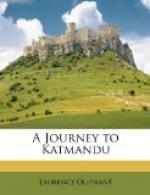The only other interesting relics in the fort are the renowned gates of Somnath, which are placed in the arsenal, and which need no description from my pen. But the greatest sight which Agra affords is the far-famed Taj Mahal: situated on the banks of the river, it is a conspicuous object from every quarter, and is as beautiful in its proportions when seen from a distance as in its details when more closely and minutely inspected: an unfailing source of gratification to the beholder, it well merits repeated visits. In its vastness, in its costly material, in its beautiful proportion, and in its delicacy of detail, it stands a noble monument of the talent which devised, and of the skill which executed it. It is said to have incessantly occupied 20,000 men for 22 years, and three million pounds sterling were expended upon it.
The intention of Shah Jehan, whose ashes it covers, was to have connected it by a marble bridge with a tomb exactly similar on the opposite side of the river, in which were to be interred the remains of his wife. This vast design he never lived to accomplish, and his son, who was of an economical turn of mind, did not consider the maternal ashes worth a further expenditure of three millions, and so Shah Jehan and his wife lie buried in one tomb, which may safely be pronounced the most magnificent in the world.
* * * * *
I like the Indian system of starting on a journey after dinner. When other people are going to bed, you get into your comfortable palanquin, and wake up 30 miles from your companions of the previous evening, who are only beginning to rub their eyes, when you have already actively commenced the work of exploring the sights at your destination. Thus did I inspect the old city of Futtehpore Secreh under the guidance of Busreet Alee, a garrulous old man, and a perfect specimen of a cicerone, with whom I at once plunged into the most extensive ruins I had seen in India: cloisters, colonnades, domes, walls, kiosks, and turrets, heaped together in the utmost confusion, a mass of red sandstone, except when some white marble denoted a more sacred or interesting spot as it glistened in the beams of the rising sun.
Ackbar, the founder of the spacious palaces here situated, was an exception to the general rule of Eastern potentates, and his residence must have been even more magnificent than the handsome tomb of Secundra, in which his ashes repose. The legend regarding the reason for which Futtehpore Secreh was pitched upon by the monarch as his seat of government is somewhat singular. It seems that he had long desired a successor to perpetuate his great name, and rule over his vast dominions, the possession of most of which he owed to his own strong arm and fertile genius: it was therefore a great disappointment to him that the wished-for prince did not make his appearance. Ackbar accordingly consulted Shah Selim Shurstre upon this important subject, and Shah Selim Shurstre, who lived at Futtehpore




